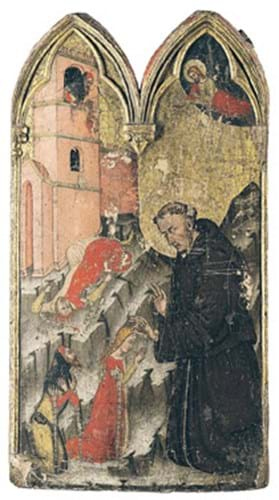
The gold ground panel, a highlight of the sale of the Alberto Bruni Tedeschi (1915-1996) collection sold by Sotheby's on March 21, shows a little known incident in the life of Saint Anthony of Padua. The miracle apparently took place in 1226-7 when Saint Anthony was custos of the Franciscan convent of Solignac, near Limoges.
A young woman is said to have jumped from a window to escape the cruelty of her jealous husband, only to find herself falling to her death as her hair detached from her scalp. Saint Anthony is said to have healed her, leading her husband to repent.
Although the miraculous event is described in the Liber Miraculorum (1367-1374), the artist must have used an earlier source for the painting since it dates from around 1350.
The narrative is depicted as two separate episodes: in the left background a man leans out of a tower holding the two braids of the woman lying bleeding at the foot of the building. In the foreground, Saint Anthony, wearing the habit of the Franciscan order, is shown blessing the woman kneeling before him - her scalp healed and with a healthy head of auburn hair. Her husband kneels in a repentant pose before the saint while the presence of the figure of Christ to the arch indicates that a miracle has taken place.
If the subject matter is obscure then the search for the artist has required similar levels of detective work.
It was only during cataloguing for the sale that the 2ft 3in x 15in (69 x 35cm) panel was recognised as a missing element from a polyptych of which three other elements had been identified.
Other panels sharing the same distinctive gothic arched frame include Saints Louis of Toulouse and John the Baptist, with a praying friar and a pinnacle representing Saint Paul.
However, from the same altarpiece is an inscribed and dated panel, The Coronation of the Virgin with five angels in the Thyssen-Bornemisza Museum, Madrid. The date of 1355 has given rise to the name 'The Master of 1355'.
The link to Saint Anthony of Padua was made by the renowned specialist in early Italian painting, Professor Miklos Boskovits of the Universita degli Studi di Firenze. He had referred to the picture in his 1993 book on the Thyssen collection but then had described its whereabouts as unknown.
So who was The Master of 1355?
The early provenance of the altarpiece is not recorded, nor is it known when the altarpiece was dismembered, but it is likely to have been painted for a Franciscan church, perhaps in Bologna.
The inscription on the Thyssen panel specifies the patron's birthplace as Montezago in the region of Lugagnano Val d'Arda, in the province of Piacenza.
Since the 1930s the Thyssen painting had been variously attributed to Venetian artists Jacopo di Cione and Nicolò Semitecolo. However, in the 1970s it was suggested the panels might be Emilian, and by an artist working in Piacenza c.1325-75, rather than Venetian.
Professor Miklos Bosk-ovits' positive identification added significantly to its commercial worth - but so did the unusual subject matter.
Rarity does not always translate into pounds and pence, but on this occasion bidding for the panel - acquired by Alberto Bruni Tedeschi in Turin around 30 years ago - more than quadrupled hopes at £170,000. The buyer was an American collector.
By Roland Arkell




